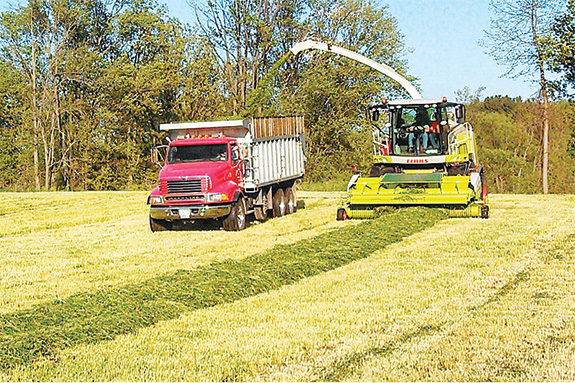What farmers have discovered is that there is considerable sunlight and moisture for forage production after corn silage and before much of the spring corn planting.
Capturing this with a winter forage adds directly to the feed supply from that same acre at a relatively low cost.
In the six to eight years of our management research on this crop at Cornell’s Valatie research farm, yields have moved up from the 2.25 tons of dry matter (6.4 tons silage) to 3.5 to 4.5 dry matter tons (10 to 12 tons silage), as harvested about May 12-18 in the Albany, New York area.
Farmers and researchers have found they can harvest winter triticale and come back with a slightly shorter-season corn or one of the new BMR sorghums in a double-crop system even in the more northern areas of the U.S. and southern Canada. This boosts total yearly yields 25 percent or more over the single-crop system.
What has generated the real excitement is that farms have found winter triticale produces some of the highest-quality forage they have grown.
It is harvested in normally cool spring, which produces very high digestibility and sugar content (10 to 20 percent sugar is not uncommon at mowing).
In winter triticale this year, in vitro total digestibility (IVTD) 24 is running 80 percent on fermented samples with Kd per hr rates (indicating rate of dry matter digestion in the rumen) of 5, 6 or even 7.
Add to this the lower cost of production of a ton of dry matter, and you have a nice replacement for some of the purchased concentrate brought on the farm.
Because a well-established crop is critical for high yields the next spring, producers are willing to make an extra effort to have a fall planting that produces more ground cover and holds more nutrients than many cover crops.
Most of the information for winter grain production is exactly the opposite for winter forage production. We want to maximize the number of tillers produced in order to maximize spring yield. This means ideally planting one to two weeks earlier than wheat.
We found September 10 planting date (10 days earlier than wheat in the Albany, New York area) yields 35 percent more than October 5 planting date (the normal cover-crop planting date).
This early date is after many acres of corn silage have been harvested. Increasing the fall nitrogen rates has directly increased the tillers and spring yield only if the crop is planted early enough in the fall.
Ongoing research is looking at pre-priming the fall crop with manure incorporated before planting to increase tillering and safely store the nitrogen for next year’s rapid spring growth.
This has the potential to simultaneously increase yield while decreasing cost. Spring nitrogen is essential for both high yields and high crude protein.
Adequately fertilized, protein commonly runs 16 to 18 percent. If manure had not been applied the previous fall, it is critical that sulfur be added with the nitrogen for protein formation.
Unfortunately, spring-applied manure releases too slowly for this fast-growing crop, so at least 50 percent of the spring nitrogen needs to come from fertilizer at this stage of our research.
No new crop is without accompanying mistakes. Our job, through research, is to make most of them beforehand, so you can profit from our mistakes.
Certified seed, especially treated seed, gets the crop off to a rapid fall start. In our trials last year, we had a major outbreak of snow mold over the winter that destroyed 80 percent of some varieties. All the commercially available certified varieties in our test came through without a problem.
Another potential problem is how the crop is planted. On many farms in the Northeast, a complete generation has passed since small grains were grown, so producers are making old mistakes.
Winter triticale will survive very tough winters if it is planted 1.25 inches deep. If not planted deeply enough, it heaves in the spring thaw – and the roots are air-pruned.
Earlier fall planting and minimum tillage to loosen the soil after corn silage (and incorporate manure) allows tremendous development of roots to resist heaving. We don’t broadcast and disk in corn, so why do it for winter triticale forage?
Harvest is simple when you ask yourself what you’re feeding it to. This is not a one-shot crop where if you miss that one prime harvest day it turns to garbage.
As the Bible says, there is a time for each season. For peak-lactating cows, harvesting winter forage at flag leaf gives high yield and high quality.
Some tried to jump the season last year by harvesting five days before flag leaf, giving up 24 percent of the yield. Missing the flag leaf (often occurring over a three-day timeframe) does not mean you have garbage.
In our tests last year, eight days after flag leaf on fresh samples we were still at an IVTD 24 (in vitro total digestibility in 24 hours) of 83, NDFD 24 (neutral detergent fiber digestibility in 24 hours) of 70 and a Kd per hr of 8.15.
This will vary tremendously depending on how hot the temperature is (we were cool during this period) to drive the quality down.
Some farms are waiting until late milk or early soft dough for a very high-yielding (15 to 20 tons silage per acre), premium dry-cow or heifer forage.
Research we have in the ground this fall will quantify and qualify this new harvest window and the impact of adding legumes at planting to this special forage to produce a nearly complete TMR feed right in the field.
Most farms are shocked when they start harvest. They don’t expect that much forage in the middle of corn planting. They are also not ready for 6 to 12 tons of silage to go through their mower.
Full-width swath is critical for drying, but conditioning has not helped in our research. Slowly tedding (speed will make tedder lumps and wreck the machine) after three to four hours of drying will help tremendously.
Ensiling the same day as mowing with a homolactic bacterial inoculant will allow full fermentation of the wetter forage utilizing the high sugar content. If night temperatures go down to the 30ºF range, as they often do at this time of year, then you could allow it to sit overnight with minimal sugar losses and use the next day to further remove moisture.
A word of caution with all winter grains for forage – they have allelopathic compounds that can affect the next crop. Corn, sorghum species, teff and many small-seeded grasses will not grow until the compounds dissipate or are tilled into the soil.
Zone tillage will mix soil and allow row crops to be planted. Legumes such as soybeans have not shown any affect by the allelopathy. FG
PHOTO
Farms such as RL Jeffres and Sons, in Wyoming, New York are one of many who have discovered the impressive yield of very high-quality forage produced by winter triticale. This crop was immediately followed by corn or soybeans. Photo courtesy of Tom Kilcer.












